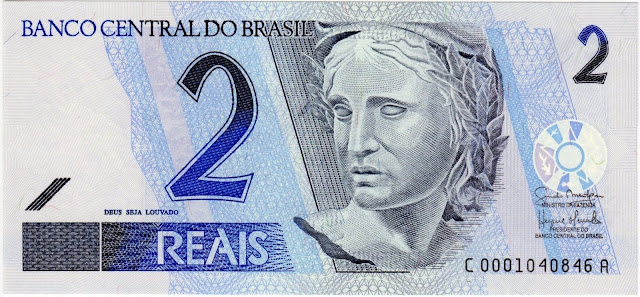Brazil Banknotes 2 Reais banknote 2010
Central Bank of Brazil - Banco Central do Brasil
Obverse: The Effigy of the symbolic sculpture of the Republic of Brazil (Portuguese: Efígie da República) is used as a national personification, both in Brazil and in Portugal, symbolizing the Republic. Inscription: "God Be Praised" (Portuguese: DEUS SEJA LOUVADO).
Reverse: Picture of a Hawksbill Turtle and three baby sea turtles (Eretmochelys imbricata), one of the five sea turtle species found in the Brazilian coast.
Watermark: The hawksbill sea turtle and electrotype "2".
See-through register: Coat of arms of Brazil.
Colors: blue, olive.
Size: 140 x 65 mm.
Printer: Casa da Moeda do Brasil (CMB).
Signatures: Ministério da Fazenda: Guido Mantega.
Presidente do Banco Central do Brasil: Henrique de Campos Meirelles.
Brazilian Currency Banknotes - Brazil Paper Money
July Monetary Reform: 1 Real = 2750 Cruzeiros Reais
1994-2012 "Real" Issue
Hawksbill sea turtle
The hawksbill sea turtle (Eretmochelys imbricata) is a critically endangered sea turtle belonging to the family Cheloniidae. It is the only extant species in the genus Eretmochelys. The species has a worldwide distribution, with Atlantic and Indo-Pacific subspecies — Eretmochelys imbricata imbricata and Eretmochelys imbricata bissa, respectively.
The hawksbill's appearance is similar to that of other marine turtles. In general it has a flattened body shape, a protective carapace, and flipper-like arms, adapted for swimming in the open ocean. Eretmochelys imbricata is easily distinguished from other sea turtles by its sharp, curving beak with prominent tomium, and the saw-like appearance of its shell margins. Hawksbill shells slightly change colors, depending on water temperature. While this turtle lives part of its life in the open ocean, it spends more time in shallow lagoons and coral reefs.
Human fishing practices threaten Eretmochelys imbricata populations with extinction. The World Conservation Union classifies the hawksbill as critically endangered. Hawksbill shells were the primary source of tortoiseshell material used for decorative purposes. The Convention on International Trade in Endangered Species outlaws the capture and trade of hawksbill sea turtles and products derived from them.
Anatomy and morphology
Eretmochelys imbricata has the typical appearance of a marine turtle. Like the other members of its family, it has a depressed body form and flipper-like limbs adapted for swimming.
Adult hawksbill sea turtles have been known to grow up to 1 m (3 ft) in length, weighing around 80 kg (180 lb) on average. The heaviest hawksbill ever captured was measured to be 127 kg (280 lb). The turtle's shell, or carapace, has an amber background patterned with an irregular combination of light and dark streaks, with predominantly black and mottled-brown colors radiating to the sides.
Several characteristics of the hawksbill sea turtle distinguish it from other sea turtle species. Its elongated, tapered head ends in a beak-like mouth (from which its common name is derived), and its beak is more sharply pronounced and hooked than others. The hawksbill's arms have two visible claws on each flipper.
Profile photo of animal head with prominent beak protruding above lower jaw, a faceted head covering surrounds the eye
One of the hawksbill's more easily distinguished characteristics is the pattern of thick scutes that make up its carapace. While its carapace has five central scutes and four pairs of lateral scutes like several members of its family, E. imbricata's posterior scutes overlap in such a way as to give the rear margin of its carapace a serrated look, similar to the edge of a saw or a steak knife. The turtle's carapace has been known to reach almost 1 m (3 ft) in length.
Hawksbill sea turtles' sand tracks are asymmetrical, because they crawl on land with an alternating gait. By contrast, the green sea turtle and the leatherback turtle crawl rather symmetrically.
Due to its consumption of venomous cnidarians, hawksbill sea turtle flesh can become toxic.

